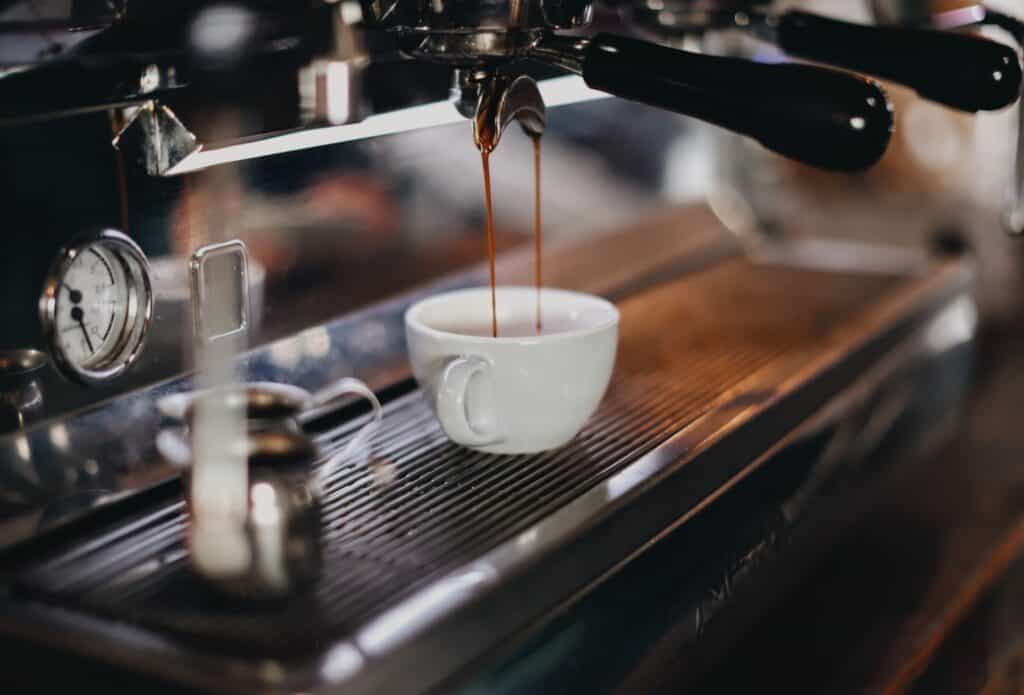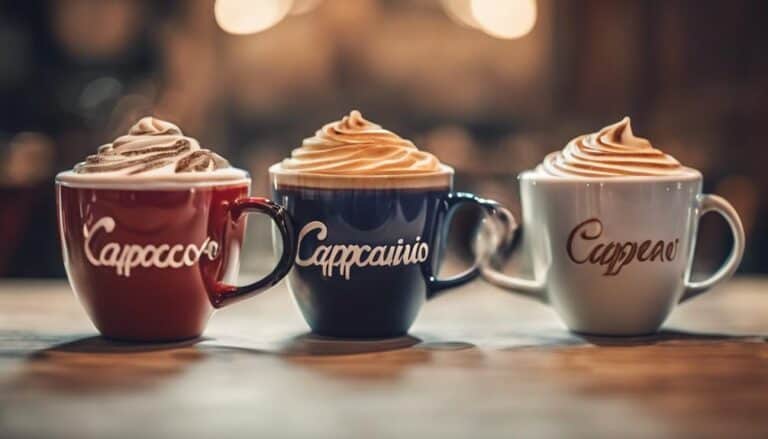Latte vs Cappuccino vs Macchiato: Understanding the Differences

Latte, cappuccino, and macchiato are all espresso-based drinks that have become staples in coffee shops around the world. Despite their similarities, there are distinct differences between the three that can make all the difference when it comes to choosing your go-to coffee order.
In this article, we’ll take a deep dive into the world of latte, cappuccino, and macchiato, exploring their unique qualities and helping you decide which one is right for you.
Understanding the differences between these drinks starts with understanding espresso. Espresso is a concentrated coffee that is made by forcing hot water through finely ground coffee beans. It is the base for all three drinks, but what sets them apart is the amount and type of milk that is added.
A latte, for example, is made with steamed milk and a small layer of foam, while a cappuccino is made with equal parts espresso, steamed milk, and foam. A macchiato, on the other hand, is made by adding a small amount of steamed milk to a shot of espresso, creating a layered effect.
Understanding Espresso-Based Drinks
Espresso-based drinks are a popular coffee choice for many people. They are made from a base of espresso, which is a concentrated form of coffee that is brewed by forcing hot water through finely ground coffee beans. Espresso is the foundation of many popular coffee drinks, including lattes, cappuccinos, and macchiatos.
The Role of Espresso
Espresso is the key ingredient in espresso-based drinks. It is a concentrated form of coffee that is brewed by forcing hot water through finely ground coffee beans. The result is a strong, bold flavor that is the foundation of many popular coffee drinks.
The amount of espresso used in each drink varies depending on the specific drink. For example, a single shot of espresso is typically used in a macchiato, while a cappuccino typically contains two shots of espresso. A latte can contain one or two shots of espresso, depending on the size of the drink.
The Art of Pulling a Shot
Pulling a shot of espresso is an art form that requires skill and practice. It involves using an espresso machine to force hot water through finely ground coffee beans at a high pressure. The result is a concentrated shot of coffee that is the foundation of many popular coffee drinks.
To pull a shot of espresso, the barista must first grind the coffee beans to the appropriate consistency. The grounds are then placed in a portafilter, which is inserted into the espresso machine. The machine is then activated, and hot water is forced through the grounds at a high pressure.
The resulting shot of espresso should be thick and creamy, with a layer of crema on top. The crema is a golden-brown foam that forms on top of the espresso shot and is a sign of a well-pulled shot.
Overall, espresso-based drinks are a delicious and popular coffee choice for many people. Understanding the role of espresso and the art of pulling a shot is key to creating a delicious and satisfying drink.

Latte: A Deep Dive
Latte, also known as caffe latte, is a popular espresso-based drink that originated in Italy. It is made by combining a shot of espresso with steamed milk, and a thin layer of milk foam on top. The coffee to milk ratio in a latte is typically 1:3 or 1:4, making it a milky and smooth drink that is perfect for coffee lovers who prefer a less intense coffee flavor.
One of the key ingredients in a latte is steamed milk. Baristas use a steam wand to heat and aerate the milk, creating a microfoam that gives the latte its signature texture and taste. The milk foam on top of the latte is typically made by frothing the milk with a steam wand until it has a thick and frothy consistency. The foam adds volume to the drink and gives it a rich, creamy taste.
The ratios of espresso, steamed milk, and milk foam can vary depending on the recipe and the preferences of the drinker. Some coffee shops offer variations of the classic latte, such as an iced latte or a flavored latte with added sugar or syrups. Whole milk is the most commonly used milk in a latte, but some people prefer to use non-dairy milk alternatives such as almond milk or oat milk.
Latte macchiato is a variation of the classic latte that is made by pouring steamed milk over a double shot of espresso, creating a layered effect. The milk is added first, followed by the espresso, resulting in a drink that is less intense than a traditional latte. Italian latte, also known as a hot latte, is a variation that is made with more milk and less foam than a traditional latte.
In summary, a latte is a milky and smooth espresso-based drink that is perfect for coffee lovers who prefer a less intense coffee flavor. It is made by combining a shot of espresso with steamed milk and a thin layer of milk foam on top. The ratios of espresso, steamed milk, and milk foam can vary depending on the recipe and the preferences of the drinker. Latte macchiato and Italian latte are variations of the classic latte that offer different textures and tastes.
Cappuccino: An In-Depth Look
Cappuccino is a classic Italian coffee drink that has been enjoyed by coffee lovers all over the world for decades. It is a popular choice for those who love a creamy and frothy coffee with a bold and balanced flavor. In this section, we will take an in-depth look at cappuccino and everything you need to know about this delicious coffee drink.
What is a Cappuccino?
A cappuccino is a coffee drink that is made with espresso, steamed milk, and frothed milk. It is typically served in a 6-ounce cup and is made with a 1:1:1 ratio of espresso, steamed milk, and frothed milk. The steamed milk is added first, followed by the espresso, and then the frothed milk is spooned on top.
Foam
Foam is an essential component of a cappuccino. It is created by frothing milk with a steam wand, which adds air to the milk and creates a creamy and frothy texture. The foam is what gives a cappuccino its signature look and taste.
Milk to Coffee Ratio
The milk to coffee ratio is crucial to creating the perfect cappuccino. A cappuccino should have a balanced flavor, with the espresso and milk complementing each other. The ideal ratio is 1:1:1, with equal parts espresso, steamed milk, and frothed milk.
Wet and Dry Cappuccino
A wet cappuccino has more steamed milk and less foam, while a dry cappuccino has more foam and less steamed milk. The choice between a wet or dry cappuccino is a matter of personal preference.
Flavored Cappuccino
Cappuccinos can be flavored with a variety of syrups, such as chocolate, cinnamon, or vanilla. However, it is important to note that adding flavored syrup can increase the calorie count of the drink.
Iced Cappuccino
Iced cappuccinos are a refreshing twist on the classic cappuccino. They are made with espresso, milk, and ice, and can be flavored with syrups or sweeteners. However, it is important to note that the foam in an iced cappuccino may not be as creamy as a hot cappuccino due to the ice.
Quality
The quality of the coffee beans and milk used to make a cappuccino can greatly affect the taste and overall experience of the drink. Using high-quality beans and fresh milk can result in a creamy and delicious cappuccino.
Calories
A typical cappuccino contains around 80-120 calories, depending on the size and type of milk used. However, adding flavored syrups or sweeteners can significantly increase the calorie count.
In summary, cappuccino is a classic Italian coffee drink that is enjoyed by coffee lovers all over the world. It is made with espresso, steamed milk, and frothed milk, and has a signature frothy and creamy texture. The ideal milk to coffee ratio is 1:1:1, and the drink can be customized with flavored syrups or sweeteners. The quality of the coffee beans and milk used can greatly affect the taste and overall experience of the drink.

Macchiato: A Detailed Exploration
Macchiato is an espresso-based coffee beverage that is popular in coffee shops worldwide. The word “macchiato” means “stained” or “marked” in Italian, referring to the small amount of milk that is added to the espresso.
A traditional macchiato is made by adding a splash of milk to a single or double shot of espresso. The milk is usually steamed and frothed, creating a layer of foam on top of the espresso. The result is a rich, strong coffee with a subtle sweetness and a creamy texture.
The ingredients used to make a macchiato are simple: espresso and milk. The type of milk used can vary, but most baristas use whole milk for its richness and creaminess. Some coffee shops also offer flavored macchiatos, such as caramel or vanilla, which add a touch of sweetness to the drink.
Compared to other espresso-based drinks, macchiatos are relatively low in calories and fat. A single shot macchiato with whole milk contains around 25-30 calories and 1-2 grams of fat. However, flavored macchiatos with added sugar and whipped cream can be much higher in calories and fat.
Iced macchiatos are a refreshing twist on the traditional hot drink. They are made by pouring cold milk over a double shot of espresso and adding ice. Flavored syrups can also be added for extra sweetness and variety.
In conclusion, macchiatos are a subtle and refreshing espresso-based drink that is perfect for those who enjoy a strong coffee with a touch of sweetness. Whether you prefer it hot or iced, traditional or flavored, a macchiato is a great value and a popular choice in coffee shops worldwide.
Comparisons and Contrasts
When it comes to espresso-based drinks, the latte, cappuccino, and macchiato are three of the most popular options. While they all share a common ingredient – espresso – there are some key differences between them that can affect their flavor, texture, and overall experience.
Ingredients and Ratios
A cappuccino is made with equal parts espresso, steamed milk, and frothed milk. The steamed milk adds a creamy texture, while the frothed milk creates a layer of foam on top. On the other hand, a latte is made with more steamed milk than frothed milk, resulting in a creamier texture and milder coffee flavor. A macchiato, meanwhile, is simply a shot of espresso with a small amount of steamed milk added to it.
Flavor and Taste
The flavor and taste of each drink can vary depending on the ratios of ingredients and the quality of the coffee used. A cappuccino tends to have a bolder, more balanced flavor, with the espresso and milk complementing each other. A latte, on the other hand, has a more subtle coffee flavor, with the milk taking center stage. A macchiato has a strong espresso flavor, with just a hint of sweetness from the steamed milk.
Texture and Volume
The texture and volume of each drink can also vary. A cappuccino has a thick layer of foam on top, with a creamy texture underneath. A latte has a thinner layer of foam and a creamier, smoother texture. A macchiato has a thin layer of steamed milk on top of the espresso shot, with a slightly thicker texture than a straight espresso.
Calories and Quality
When it comes to calories, the differences between the three drinks are minimal. A small cappuccino, latte, or macchiato typically contains around 100 calories. However, the quality of the coffee used can greatly affect the taste and overall experience of each drink. Using high-quality, freshly roasted beans can result in a richer, more flavorful espresso, which can make all the difference in a latte, cappuccino, or macchiato.
In summary, the latte, cappuccino, and macchiato each have their own unique characteristics when it comes to flavor, texture, and volume. The ratios of ingredients and the quality of the coffee used can greatly affect the taste and overall experience of each drink. Ultimately, the choice between these three drinks comes down to personal preference and what kind of coffee flavor and texture you enjoy most.
Milk Alternatives and Their Impact
When it comes to choosing the right milk for your latte, cappuccino, or macchiato, there are a variety of milk alternatives available that can cater to your dietary needs and preferences. Here are some of the most popular milk alternatives and their impact on your coffee:
Almond Milk
Almond milk is a popular choice for those who are lactose intolerant or have a dairy allergy. It has a slightly nutty flavor and a creamy consistency that works well with coffee. Almond milk is also low in calories and fat, making it a great option for those who are watching their weight. However, it is important to note that almond milk is lower in protein than cow’s milk, so it may not be the best option for those who are looking to increase their protein intake.
Coconut Milk
Coconut milk is a creamy and rich alternative to dairy milk that has a slightly sweet flavor. It is a great option for those who are vegan or lactose intolerant, as it is naturally dairy-free. Coconut milk is also high in healthy fats, which can provide a boost of energy and help you feel full for longer. However, it is important to note that coconut milk is also high in calories, so it may not be the best option for those who are watching their weight.
Oat Milk
Oat milk is a popular choice for those who are looking for a dairy-free alternative that is also high in protein. It has a creamy consistency that works well with coffee and a slightly sweet flavor. Oat milk is also low in calories and fat, making it a great option for those who are watching their weight. However, it is important to note that oat milk is not suitable for those who have a gluten intolerance or allergy.
Nutritional Value
When it comes to choosing the right milk for your coffee, it is important to consider the nutritional value of each option. Cow’s milk is a great source of protein and calcium, while almond milk is low in calories and fat. Coconut milk is high in healthy fats, while oat milk is high in protein. Ultimately, the choice of milk alternative will depend on your individual dietary needs and preferences.
Coffee Culture Around the World
Coffee is a staple beverage in many parts of the world, and each region has its unique coffee culture. Here’s a brief overview of how coffee is enjoyed in different parts of the world:
Italy
Italy is famous for its espresso culture, where people drink small shots of strong coffee throughout the day. Cappuccinos are generally consumed in the morning, and it’s considered a faux pas to order one after 11 am. Macchiatos are also popular in Italy, and they are often served as a small shot of espresso with a dollop of milk foam on top.
Australia
In Australia, coffee culture is centered around specialty coffee shops that serve a variety of espresso-based drinks. Cappuccinos and lattes are popular choices, and they are often served with latte art. Australians also enjoy a unique drink called the “flat white,” which is similar to a latte but with less foam.
Europe
Coffee culture in Europe varies from country to country. In France, café au lait is a popular breakfast drink that consists of equal parts coffee and steamed milk. In Austria, people drink a beverage called Milchkaffee, which is similar to a latte but with more milk. In Spain, café con leche is a popular drink that consists of espresso and steamed milk.
America
In the United States, coffee culture is centered around coffee shops that serve a variety of espresso-based drinks. Americanos are a popular choice, which is simply espresso diluted with hot water. Cafe au lait is also a popular drink, which is similar to the French version but with a stronger coffee flavor. Breves are another unique American drink, which is similar to a latte but made with half-and-half instead of milk.
Arabica Coffee Beans
Arabica coffee beans are the most popular type of coffee bean in the world, and they are grown in many countries, including Brazil, Colombia, and Ethiopia. Arabica coffee beans are known for their mild, sweet flavor and low acidity, making them a popular choice for espresso-based drinks.
Overall, coffee culture around the world is diverse and unique, with each region having its own take on how to enjoy this beloved beverage.
Additional Coffee Options and Variations
Aside from the classic latte, cappuccino, and macchiato, there are a plethora of coffee options and variations to choose from. Here are a few popular ones:
- Iced Americano: This refreshing drink is perfect for hot summer days. It’s made by pouring espresso over ice and adding water. The result is a smooth and approachable coffee that’s less bitter than a regular iced coffee.
- Filter Coffee: For those who prefer a simpler coffee experience, filter coffee is a great option. It’s made by pouring hot water over coffee grounds and letting it drip through a filter. The result is a clean and smooth cup of coffee that’s perfect for any time of day.
- Hot Chocolate: Sometimes, you just need a break from coffee. Hot chocolate is a delicious and creamy alternative that’s perfect for satisfying your sweet tooth. It’s made by mixing cocoa powder, sugar, and milk together and heating it up until it’s hot and frothy.
- Ganache: For those who want to take their coffee to the next level, adding ganache is a great option. Ganache is a rich and decadent chocolate sauce that can be added to coffee for a creamy and indulgent experience.
- Marshmallows: Want to add a little sweetness to your coffee without going overboard? Marshmallows are a great option. They add a subtle sweetness and a fun texture to any cup of coffee.
- Creamier Options: For those who prefer a creamier coffee experience, there are a few options to choose from. Adding cream, milk, or even coconut milk can help create a creamy and indulgent coffee experience.
- Water: While it may seem obvious, the quality of the water used in your coffee can have a big impact on the final product. Using filtered or purified water can help ensure that your coffee tastes its best.
Overall, there are countless ways to enjoy coffee. Whether you prefer a classic latte or want to try something new and exciting, there’s a coffee out there for everyone.
Frequently Asked Questions
What is the difference between a latte macchiato and a cappuccino?
Both latte macchiato and cappuccino are espresso-based drinks that contain steamed milk. However, the main difference lies in the ratio of milk to espresso. A latte macchiato has more milk and less espresso than a cappuccino. Additionally, the milk in a latte macchiato is steamed and poured over the espresso, whereas in a cappuccino, the milk is steamed and frothed before being poured over the espresso. This creates a different texture and taste in each drink.
Which is stronger: latte or cappuccino?
In terms of caffeine content, both latte and cappuccino contain the same amount of espresso. However, due to the difference in milk and foam ratios, a cappuccino may taste stronger than a latte. This is because the foam in a cappuccino creates a more intense flavor, while the milk in a latte creates a smoother, creamier taste.
What’s the difference between a macchiato and a flat white?
A macchiato and a flat white are both espresso-based drinks, but they differ in the amount of milk used. A macchiato is a shot of espresso with a small amount of steamed milk and a dollop of foam on top. A flat white, on the other hand, is made with a double shot of espresso and a small amount of steamed milk, with little to no foam. This creates a stronger, more intense flavor in a flat white compared to a macchiato.
Which is sweeter: cappuccino, latte or macchiato?
The sweetness of a coffee drink depends on the type and amount of milk used, as well as any added sweeteners. In general, a latte may be sweeter than a cappuccino or a macchiato due to the higher milk content. However, this can vary based on personal preferences and the specific recipe used.
Are macchiatos stronger than lattes?
In terms of caffeine content, a latte and a macchiato contain the same amount of espresso. However, due to the difference in milk and foam ratios, a macchiato may taste stronger than a latte. This is because the milk in a macchiato is less than that in a latte, creating a more intense flavor.
Latte vs cappuccino: Which is healthier?
The health benefits of a coffee drink depend on the specific ingredients used and any added sweeteners. In general, a latte may be slightly healthier than a cappuccino due to the higher milk content, which provides more calcium and vitamin D. However, this can vary based on the type and amount of milk used, as well as any added sweeteners. It’s important to enjoy coffee drinks in moderation as part of a balanced diet.






One Comment